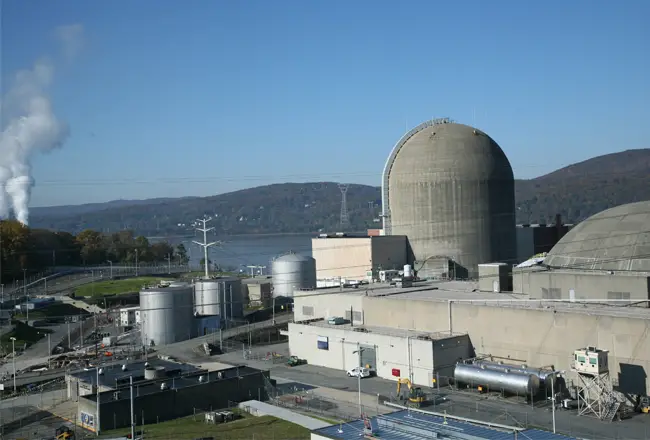New York’s energy grid can withstand the loss of Indian Point Energy Center, but it will have to rely on new sources of mostly natural gas-fired generation, according to a report from the state’s independent grid operator.

The New York Independent System Operator released its deactivation assessment on Wednesday for Indian Point’s two nuclear reactors, which are expected to shut down in 2020 and 2021. NYISO said the state’s power grid would remain reliable for the five-year period it studied (2018-23), “if sufficient replacement sources of power are added within the lower Hudson Valley.”
The two reactors at Indian Point in Buchanan produce more than 2,000 megawatts of electricity and provide a quarter of the electricity consumed by New York City and Westchester.
Indian Point owner and operator Entergy Corp. announced in January that it would shut down the two reactors on the site. The shutdown came as part of a legal settlement between Entergy, Gov. Andrew M. Cuomo’s office and Ossining environmental group Riverkeeper following a drawn-out relicensing process.
But Entergy officials said at the time that economic factors actually drove the plant’s closure. Cheap natural gas prices drove down energy costs and cut into the profitability of nuclear generation, officials said, pointing to similar plant shutdowns around the country in recent years.
Related: Left in the dark? Indian Point”™s closing will require a close look at replacement energy sources
Now, according to NYISO’s analysis, an answer to replacing Indian Point’s power may come through three new natural gas-fired plants in the region.
For its best case assessment, which found the grid would meet reliability standards post-Indian Point, NYISO assumed that the grid would add three major generation facilities currently under construction: the 678-megawatt CPV Valley Energy Center in Orange County, the 1,020-megawatt Cricket Valley Energy Center in Dutchess County and a 120-megawatt addition to the Bayonne Energy Center power station in New Jersey.
NYISO analyzed a scenario which removed all three of those plants and found a 100-megawatt need by 2021 and a 600-megawatt need by 2027.
NYISO wrote in the analysis that the “results demonstrate that, without the expected new generation facilities under construction, additional replacement sources of power would be necessary to maintain reliability following deactivation of (Indian Point).”
The analysis concluded that without the three generation facilities cited in the report, the grid’s resource needs “would need to be met by one or more types of solutions, including generation, transmission, energy efficiency and demand response measures.”
A separate report released in February, backed by Riverkeeper and the Natural Resources Defense Council, stated that the grid could maintain reliability by increasing renewable energy production and energy-efficiency measures. That report included the 1,100-megawatt Champlain Hudson Power Express, which hopes to be in service by 2022. The 333-mile transmission line would bring hydropower to the region from Quebec.























The only problem with relying on natural gas to replace Indian Point is that Cuomo and the Democrats won’t allow the pipelines to be built. The lack of pipelines is also choking the natural gas supply to New England. And let’s face it, for Westchester residents and businesses, less natural gas supply coming in to the area increases the price that we’re all paying to heat homes and run our economy. Wouldn’t hurt for NY to allow fracking too, then we’d be buying made in NY, but again the Democrats won’t allow its citizens to enrich themselves by tapping the mineral wealth in their properties.
It is unfortunate that the reporter did not cite the pages for his quotes.
On page 4 of the Generator Deactivation Assessment Indian Point Energy Center, A Report by the New York Independent System Operator on Indian Point which the above article is based on clearly lays out a scenario that the addition of “planned resources,” which are gas generators, are not necessary when Indian Point goes off line. While a shortfall of 100 MW may be needed by 2020 this does not have to be from generation. It is the same with the 600 MW that may be needed by 2027. The report is clear that
“Resource needs could potentially be met by a combination of of solutions including generation, transmission, energy efficiency and demand response measures.”
Many of these measures are already in place and their effectiveness is rising. NYISO has the stats showing this. Other studies and reports have demonstrated that going green is not only possible, it is also cost effective. It is also much better for the air we all breath for our health and that of our children not to use gas generation. New York’s ban on fracking is a wise public policy. Fossil fuels and uranium must be left in the ground if our planet and our species is to survive. New York’s Clean Power Plan points us in that direction. The report by the NYSIO confirms that the agency responsible for managing our grid is working toward “… accommodating change while ensuring continuity” ( page 71) so that in the future we can rely on clean energy now and even more so in our future emerging grid.
The New York Independent System Operator (NYISO) paints a sunny picture of how natural gas facilities “currently under construction†will replace Indian Point in 2021 (Report: After Indian Point, energy grid will need natural gas boost, Dec. 14). However, clouds are already gathering on the horizon.
While the report reassures that three natural gas plants can fill Indian Point’s 2,000-megawatt void, New Yorkers should be cautious of this optimism. For instance, one of these plants is in New Jersey – rendering us dependent on imported electricity.
Additionally, Orange County’s CPV Valley Energy Center is currently stalled awaiting a 7.9-mile-long connection to the Millennium Pipeline. The Department of Environmental Conservation inexplicably denied the water quality certification, and this decision is being challenged in federal court. Without this connector, the $1 billion plant is useless.
The one thing we know for certain today is that we have a long way to go before we truly replace the reliable, in-state generation that we’ve had for over 50 years with Indian Point. Kudos to Entergy, the plant’s operator, for having announced the closure in advance to anticipate New York’s energy needs.
We’ve now heard what the NYISO expects, but we haven’t yet heard from state leaders, the ones responsible for creating and executing a plan to provide power for our communities and businesses. It’s time for our government to ensure the bright energy future we deserve to help New York grow and prosper in the years to come.
NYSIO takes the lead on matters of generation and transmission because they are charged with running our grid. That is their job and their recommendations are based on long experience and accurate data. Do take a look at the video of January hearing in Albany when NYSIO officials and other professionals in the field of generation and transmission testified that Indian Point was no longer needed. I would hope that politicians would take their lead from those who know of what they speak.